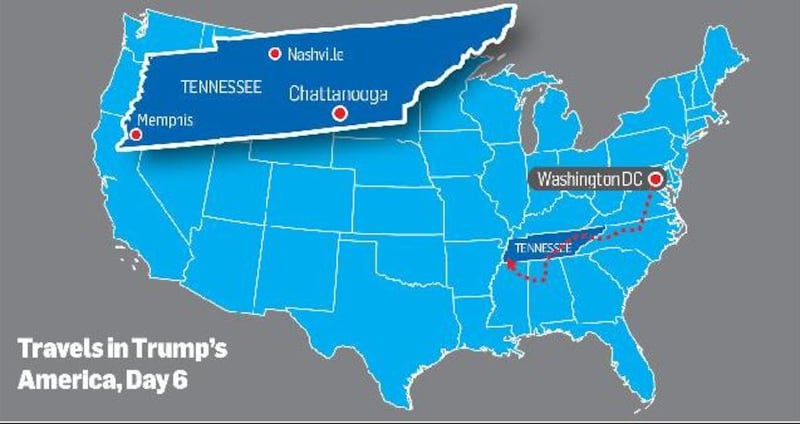In the sixth part of her series “Coast to Coast: Travels in Trump’s America”, Washington Correspondent Suzanne Lynch travels to Memphis.
Driving along the quiet roads and freeways that crisscross the states of the American south, one feature of the landscape stands out.

Alongside the ubiquitous American flags that proudly stand in front of private houses and public buildings across the country flies the lesser-known confederate flag.
The red flag with a distinctive white cross and 13 blue stars was the official flag of the confederate army – the army of the south – during the American Civil War. Today, the flag remains contentious in the United States, a symbol to many of the pro-slavery ethos of the 11 southern states that seceded and eventually lost the war.
The flag's potency as a symbol of modern race relations came to the fore in 2015 when a white supremacist shot nine people dead in a historically-black church in Charleston, South Carolina. Nikki Haley, then Republican governor, now the US ambassador to the United Nations, ordered the removal of the flag from the grounds of the statehouse.
Some 150 years after the end of a civil war that culminated in the abolition of slavery following the north’s victory, the confederate flag still stirs emotions in the country. While to many it symbolises a shameful era of race relations, to others, particularly descendants of those who fought on the southern side, is in an important part of southern identity that should not be erased.
The fiercely-contested cultural debate about the political message of the confederate flag has also spilled into the arena of public statuary. Hundreds of statues to confederate heroes including general Robert Lee and Jefferson Davis, the president of the confederate states, are dotted around the southern states of America.
Monuments
The debate about the civil war monuments has divided communities from Maryland to West Virginia to Texas.
In one of the most high-profile cases this year, New Orleans removed a statue of Lee – one of four in the city identified for removal.
Mitch Landrieu, the white New Orleans mayor, became a national figure after he delivered a powerful speech in May. "These statues are not just stone and metal. They are not just innocent remembrances of a benign history," he said. "These monuments celebrate a fictional, sanitised confederacy; ignoring the death, ignoring the enslavement, ignoring the terror that it actually stood for."
As I travel through the southern states of America – through Tennessee, Alabama and on to Arkansas – the legacy of the civil war and the consciousness of a specific "southern" identity come up again and again in my conversations with Americans. Many southerners remind me that they like to call the civil war the "war between the states", arguing that the war was about the rights of states over the federal government, not slavery.
For others, including those in the African-American community, it is a period of history that should never be celebrated.
My journey takes me to Memphis, a city that has one of the highest black populations in the country and one that is struggling with its own confederate past.
Located in the southwestern tip of Tennessee, the city also borders the states of Mississippi and Arkansas. Perched along the banks of the Mississippi, the great river that cuts across America from north to south, Memphis rapidly developed as a trading hub for cotton in the 19th century. It was also the place where thousands of freed African-American slaves settled as they migrated north after the civil war.
Its black heritage is evident in the city's rich blues tradition; while the assassination of Martin Luther King in the city put Memphis at the heart of the civil rights movement.
Irish connections
Memphis also has strong Irish connections – Irish emigrants settled in Tennessee in the 1840s and 1850s. Many joined the confederate army when Tennessee seceded from the Union, and Tyrone-born John Park was elected mayor in 1861. The Irish legacy was not always a positive one. Racial tensions and competition for work prompted one of the biggest race riots of the post-civil war era, when the Irish-dominated police force in Memphis clashed in 1866 with the black community, leaving 46 African-Americans dead.
Today, the city, which has a 65 per cent black population, confronts the same problems that cities such as New Orleans have had to face. In a downtown park, a statue of Nathan Bedford Forrest astride his horse stands proudly. The remains of Forrest and his wife are buried beneath the marble base. Forrest was not only a civil war general – he was also an early member of the Ku Klux Klan.
While Memphis City Council voted to remove the statue in 2015, the state of Tennessee passed a law that effectively overturned that decision.
Lee Millar is the head of the Memphis branch of the Sons of Confederate Veterans, an organisation that commemorates the heritage of those who fought on the southern side in the Civil War. His own ancestors fought in the war.
The Sons of Confederate Veterans brought a case, successfully, against Memphis City Council’s proposal to change the name of Forrest park.
He believes the statue of Forrest should be left in place. “I believe, and most of the residents of Memphis believe, that the statue should be preserved. It’s important to recognise our history – it helps us understand how we developed, how we came to be what we are today as a country.”
Unacceptable
But Tami Sawyer, a local African-American activist, contends that the visual celebration of Forrest is no longer acceptable. She has led several protests about the statue and the statue of Jefferson Davis, also located in the downtown area.
“In no other country do you see statues that honour people who lost a war, especially when their side reflected such hateful opinions and beliefs,” she says. “The comments people like Forrest and Davis made about black people were hugely offensive. These statues keep us stuck in the past and are disrespectful to the black people in this city.”
Tami is part of a group of activists who plan to protest this weekend outside the Orpheum theatre in the city, which is screening Gone with the Wind, the 1939 film that many believe projects a sanitised, pro-slavery vision of the American south.
“Our job is to keep letting our public representatives know that these symbols of the past are no longer acceptable, and the citizens of Memphis oppose them. In a city where the racial wealth gap is one of the largest in the country, we should be working to bring people together, not celebrate the divides of our past.”
On Monday, Suzanne travels to Little Rock and one of the US's largest evangelical churches





















